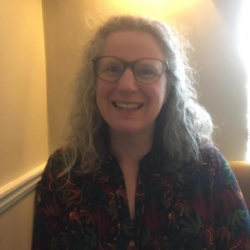Dr Nicola L C Talbot

I am a chartered mathematician and computer programmer with experience typesetting using LaTeX (pronounced “lay-tek” or “lah-tek”). I am a member of the Institute of Mathematics and its Applications and the TeX User Group. I'm an honorary lecturer at the School of Computing Sciences, University of East Anglia and am married to Professor Gavin Cawley. (Just to clear up any confusion over my name, my married name is "Mrs Nicola Cawley" and my professional name is "Dr Nicola Talbot".)
I have worked on various short-term contracts, mostly as a maths and computing research assistant, but also writing bespoke software, book production editing work, and some administrative work. I setup Dickimaw Books in 2012.
Qualifications
- B.Sc. (Hons) Class I in Mathematics at the University of Essex, 1991.
- Ph.D. entitled “An application-oriented comparison of optimisation and neural-based design techniques”. Department of Electronic Systems Engineering, University of Essex, 1996.
- CACDP Level 1 Certificate in Deaf Awareness, City College Norwich, 2003.
- CACDP Level 1 Certificate in British Sign Language, City College Norwich, 2004.
- Diploma in Creative Writing. University of East Anglia, 2011.
Programming Languages
My first introduction to programming was an undergraduate course in Modula 2 (1988–9). I then began learning BBC Basic from the Acorn manuals. I started learning C for my PhD (1991–5) and continued using it until the early 2000s, when I switched to Java. I’ve also used various scripting languages (mostly bash, Perl and PHP) and web languages (HTML, CSS and JavaScript). I started using LaTeX as a post-graduate to typeset my thesis. I have a number of open source applications available on GitHub and various LaTeX packages available on CTAN.Research Work
My research work has mostly been in the area of machine learning.
Comparison of Optimisation and Neural Network based Design Techniques
My PhD research (University of Essex, Oct. 1991—Sept. 1995) was concerned with an investigative comparison of artificial neural networks and conventional optimization methods for use in computer-aided design of VLSI integrated circuits. The areas of placement and filter design were identified as suitable areas of research.
My PhD was funded by the EPSRC.
Index Assignment for Vector Quantisation
I collaborated (Mar.–Sept. 1996) with Professor Gavin Cawley (School of Computing Sciences, University of East Anglia) on research into index assignment for vector quantisation of speech and image signals over noisy image channels where the code book is reordered to minimise the effects of errors introduced by noise in the transmission channel.
A Bayesian Approach to Food Safety
At the Institute of Food Research, Norwich (Oct. 1996–Sept. 1999), I worked with Dr Gary Barker and Professor Mike Peck on risk assessment for the hazards associated with foodborne botulism and, in particular, hazards associated with the sous vide food manufacturing process, using Bayesian belief networks. Projects were funded by the former Ministry of Agriculture Fisheries and Food (now called the Department for Environment Food and Rural Affairs) and the European Union.
The Institute of Food Research (IFR) has since become part of the Quadram Institute.
Support Vector Machines
I occasionally (2001–2012) collaborated in work on kernel learning methods with Professor Gavin Cawley. Kernel learning methods, and in particular the Support Vector Machine, at that time represented the state-of-the-art in statistical pattern recognition. Our work concentrated on the use of non-standard loss functionals, learning sparse and parsimonious representations and efficient metrics for model selection.
Interviews
Books
LaTeX
- LaTeX for Complete Novices Nicola L. C. Talbot. Dickimaw Books, 2012. ISBN 978-1-909440-00-5
- Using LaTeX to Write a PhD Thesis Nicola L. C. Talbot. Dickimaw Books, 2013. ISBN 978-1-909440-02-9
- LaTeX for Administrative Work Nicola L. C. Talbot. Dickimaw Books, 2015. ISBN 978-1-909440-07-4
Novels
- The Private Enemy Nicola L. C. Talbot. Dickimaw Books, 2014. ISBN 978-1-909440-05-0
Short Story E-books
- I’ve Heard the Mermaid Sing Nicola L. C. Talbot. Dickimaw Books, 2013. ISBN 978-1-909440-04-3
- Unsocial Media Nicola L. C. Talbot. Dickimaw Books, 2023. ISBN 978-1-909440-12-8
- Smile for the Camera Nicola L. C. Talbot. Dickimaw Books, 2024. ISBN 978-1-909440-13-5
- The Briefcase Nicola L. C. Talbot. Dickimaw Books, 2024. ISBN 978-1-909440-14-2
- Nicola L. C. Talbot. The Town House, in Tales for Our Times. 2024. Smokehouse Press. pp. 13–21.
- Nicola L. C. Talbot. The Disinterment, in Tales for Our Times. 2024. Smokehouse Press. pp. 51–53.
Children’s Books
- The Foolish Hedgehog Written by Nicola L. C. Talbot, illustrated by Magdalene Pritchett. Dickimaw Books, 2012. ISBN 978-1-909440-01-2
- Quack, Quack, Quack. Give My Hat Back! Written by Nicola L. C. Talbot, illustrated by Magdalene Pritchett. Dickimaw Books, 2013. ISBN 978-1-909440-03-6
- Cuac, Cuac, Cuac. ¡Devuélveme mi sombrero ya! Written by Nicola L. C. Talbot, illustrated by Magdalene Pritchett, translated by Gonzalo Medina. Dickimaw Books, 2013. ISBN 978-1-909440-06-7
